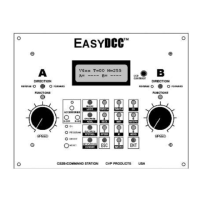73
Creating and Using Routes
Route Control - Simplify Complex Trackage the EasyDCC Way
EasyDCC includes true "route control" for turnouts driven by our AD4 accessory decoders. A
route is nothing more than a group of turnouts that are aligned to send a train down a specific path.
For example, complex junctions, yard ladder tracks, and large staging yards can be setup to route
trains down specific tracks through the use of a simple two digit address, controllable from any
throttle or the Command Station. Route control allows a large number of turnouts to be thrown, in
a specific direction, with only the push of a few keys.
Route Control - Capabilities, Requirements and Terminology
?The Command Station has room for 63 unique routes
?Routes are numbered from 1 to 63
?Up to 32 turnouts per route
?Each turnout may be set to a specific direction
?Turnouts may be placed into multiple routes with different directions
?Local control can override route setting for any single turnout
Turnout Number is shown in illustration A as yyyy. This is the address of the decoder which
powers the turnout. A route may use any valid accessory decoder address number.
Turnout Direction is described as being either "normal" or "reverse" and is shown as R or N in
the illustrations. This means the turnout is set for either for the mainline (normal) or off-main line
(reverse). You may choose other orientations such as straight or curved. Whichever wording is
used, you must be consistent, as it will help during creation of the various routes.
Route Number is unique and related to a set of turnout numbers and directions. For example B,
there are three turnout numbers with four routes; #1, #2, #3 and #4.
Routes Can Be Set NORMAL or REVERSE. The setting of a route NORMAL, throws all the
turnouts as specified when the route was created. The route may also be set REVERSE which
throws all turnouts opposite of what was specified in the route. The use of this feature will be
described the complex route examples.
Sketch The Track Diagram Before Starting
A track diagram does not have to be neat or an exact replica of the trackage. Just be sure to mark
the turnout's orientation and its decoder address. Any address may be used as long as you keep a
record of which turnout is assigned to which address. Keep a copy of the sketch in case you forget
how the route works.
Identify The Routes
Illustration B will be used to show how easy it is to create a route using some simple shorthand
notes. The "shorthand" will also be used when the route is entered into the command station. This
first example will describe the routes shown in B.
In words, Route # 1 is Turnout 101 thrown Normal. In shorthand: #1 = 101n. For Route #2,
turnout 101 is thrown Reverse AND turnout 102 is thrown Reverse.
In shorthand: #2 = 101r + 102r.
Shorthand is used for the remaining routes
#3 = 101r + 102n + 103r
#4 = 101r + 102n + 103n
Complex Routes
Creating complicated routes is nothing more than imagining the path the train will travel to move
from a one point to another. Keep a record of all turnouts encountered on this path and their
orientation. Then create the shorthand description of the route. Illustrations C and D illustrate
two more complicated routes.

